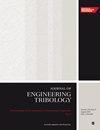典型剪切粘度对分析弹性流体动力润滑膜厚度预测的影响:经典方法的一个关键问题
IF 1.8
3区 工程技术
Q3 ENGINEERING, MECHANICAL
Proceedings of the Institution of Mechanical Engineers, Part J: Journal of Engineering Tribology
Pub Date : 2024-01-08
DOI:10.1177/13506501231224005
引用次数: 0
摘要
许多对实际机器集中接触处油膜厚度的工程估算,都是通过在钢制弹性流体动力钻机上对玻璃中的弹性流体动力润滑油膜厚度进行测量后推算出来的。由于粘度与剪切力的关系,这种估算可能存在较大误差。由于忽略了粘度计中测得的实际压力-粘度响应,因此除了室温下的一些牛顿参考液体外,所采用的经典膜厚公式尚未得到验证。在线性接触计算中使用了具有轻度剪切稀化的聚α烯烃基础油混合物,以评估剪切粘度对经典膜厚公式幂律指数的影响。压力-粘度系数和固体弹性模量的指数对非牛顿效应并不敏感。环境压力粘度和速度指数因剪切稀化而略有降低。压力和刻度的指数则因剪切作用而大大增加。在弹性流体动力装置中测量薄膜厚度以获得有效的"[公式:见正文]值 "并将其用于经典牛顿薄膜厚度公式的通常做法,会夸大在弹性流体动力润滑入口中与剪切力有关的液体的薄膜厚度。本文章由计算机程序翻译,如有差异,请以英文原文为准。
Effects of a typical shear dependent viscosity on analytical elastohydrodynamic lubrication film thickness predictions: A critical issue for the classical approach
Many engineering estimates of the film thickness in the concentrated contacts of real machines have come from extrapolations of measurements of elastohydrodynamic lubrication film thickness performed in glass on steel elastohydrodynamic rigs. Such estimates are likely to have large errors due to shear dependence of viscosity. The classical film thickness formulas employed have not been validated except for some Newtonian reference liquids at room temperature because the real pressure-viscosity response measured in viscometers has been ignored. A blend of polyalpha olefin base oils with mild shear-thinning has been employed in a line contact calculation to assess the effects of shear-dependent viscosity on the power-law exponents of the classical film thickness formula. The exponents on the pressure-viscosity coefficient and on the elastic modulus of the solids are not sensitive to the non-Newtonian effect. The exponents on ambient pressure viscosity and velocity are slightly reduced by shear-thinning. The exponents on pressure and scale are substantially increased by the shear dependence. The usual practice of measuring film thickness in an elastohydrodynamic rig to obtain an effective “[Formula: see text]-value” to use in a classical Newtonian film thickness formula will overstated the film thickness of a liquid which is shear dependent in the elastohydrodynamic lubrication inlet.
求助全文
通过发布文献求助,成功后即可免费获取论文全文。
去求助
来源期刊

CiteScore
4.20
自引率
5.00%
发文量
110
审稿时长
6.1 months
期刊介绍:
The Journal of Engineering Tribology publishes high-quality, peer-reviewed papers from academia and industry worldwide on the engineering science associated with tribology and its applications.
"I am proud to say that I have been part of the tribology research community for almost 20 years. That community has always seemed to me to be highly active, progressive, and closely knit. The conferences are well attended and are characterised by a warmth and friendliness that transcends national boundaries. I see Part J as being an important part of that community, giving us an outlet to publish and promote our scholarly activities. I very much look forward to my term of office as editor of your Journal. I hope you will continue to submit papers, help out with reviewing, and most importantly to read and talk about the work you will find there." Professor Rob Dwyer-Joyce, Sheffield University, UK
This journal is a member of the Committee on Publication Ethics (COPE).
 求助内容:
求助内容: 应助结果提醒方式:
应助结果提醒方式:


